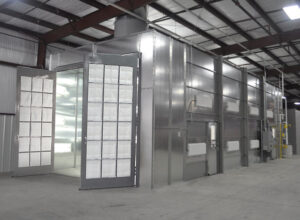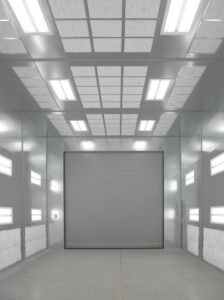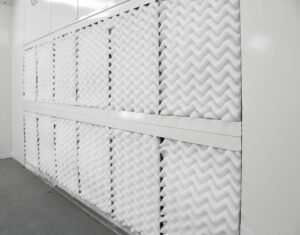The filters you choose for your truck refinish paint booth ? and how well you maintain them ? can have a direct impact on everything from booth efficiency and paint finish quality to booth maintenance costs and the safety of technicians. But before you select your booth filters, it?s important to understand all your booth?s filtration locations and the types of filters that can be used for each location.
Air Make-Up Filters
Depending on your paint booth setup, the first line of filtration defense may be in the air make-up unit, which provides pressurized air to the booth. These filters trap large particles before air reaches the air make-up unit. In addition to protecting the air make-up unit itself, these filters play an important role in extending the life of more expensive intake filtration further down the line. Relatively inexpensive, air make-up filters are sometimes known as a sacrificial layer.
Intake Filters
You likely wouldn?t know it because they are invisible to the naked eye, but particles as small as 10 microns can cause defects in your paint job. For reference, that?s about 0.0004 inches. A paint booth relies on high-quality intake filtration to remove these particles before they can contaminate the paint job.
Intake filters are often internally-supported polyester panel filters or linked panel filters, which are typically designed to be installed without the aid of clips or other mounting hardware to create a leak-free static fit when inserted into the frame. Your paint booth?s airflow style determines the type and efficiency of intake filter used.
Crossdraft Booths: In crossdraft booths, air is either pulled through a filtered intake door or pushed through a filtered intake plenum. Global Finishing Solutions® (GFS) supplies intake filters for crossdraft booths with a MERV (minimum efficiency reporting value) 7 rating, which is higher than the industry standard.
Side Downdraft, Semi-Downdraft and Downdraft Booths: Air is introduced into these booths through a filtered ceiling. The diffusion-type media pad used for ceiling intake filtration is much more efficient, with a rating of MERV 10 or higher. This rating ensures an internal cleanroom atmosphere that removes more than 99 percent of all particles 10 microns or larger from the air entering the booth.
Exhaust Filters
Where intake filters ensure that you are working with clean air from the start, exhaust filters ensure the air leaving the booth is safe for the environment, while also preventing potentially dangerous chemicals from remaining in the booth.
Exhaust filtration also protects your fans, exhaust stack and plenum from the buildup of overspray contamination. To do this effectively, exhaust filters need to hold enough paint to avoid constantly replacing them. At same time, these filters must provide a minimal pressure drop in the booth to ensure particles don?t harden and end up on the painted surface.
Traditional exhaust filters are generally single-stage filtration media made of multilayered polyester and/or fiberglass. Differences in fiber configuration, density and composition impact how exhaust filters will perform. With a 99.94 percent particle removal efficiency and holding capacity of 4.4 pounds, GFS Wave filters are designed to meet or exceed the performance of the original equipment filters.
The same type of exhaust filter can be used in crossdraft, side downdraft, semi-downdraft and downdraft booths but the location and frame configuration differ:
Crossdraft and Semi-Downdraft Booths: Exhaust filters are secured to the plenum located at the rear of the booth.
Side Downdraft Booths: Air is pulled into floor-level filtered exhaust plenums on both sides of the booth.
Downdraft Booths: Filters are located in the exhaust pit in the floor.
Filter Maintenance
Just as important as deciding which filters to use is establishing a regular schedule for changing your intake and exhaust filters. The cleanliness of your spray booth and the work you do within depend heavily on it. Clogged or overloaded filters may not allow proper airflow through the booth, causing dust or overspray to recirculate through the booth and affect the finish of your paint job.
Beyond that, it is also an important step in ensuring your paint operation meets the health and safety standards required by OSHA and NFPA regulations. In more severe situations, clogged filters may create flammable or explosive conditions within your booth.
Filters will reach their ?target? reading and require replacement at varying rates. These rates also depend upon the paint type, booth design, fan speed, temperature, spray equipment, etc. One way to establish a change-out schedule for exhaust filters is to compare readings from a manometer or magnehelic pressure gauge with the booth manufacturer?s specs. Without a pressure gauge, it is best to establish a strict maintenance schedule based on the volume of spraying taking place on a day-to-day basis.
Ultimately, it is best to work with your spray booth manufacturer or filter supplier to design an effective schedule for changing your filters that finds a good balance between filtration needs and cost efficiency in your booth?s performance. GFS and many of their distributors throughout North America offer preventative maintenance plans ? with quarterly, annual and just-in-time filter replacement offerings ? to take the hassle out of paint booth filter maintenance.



